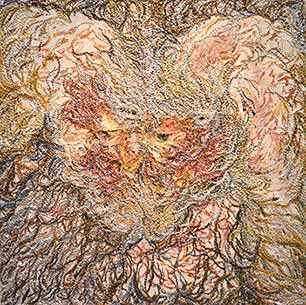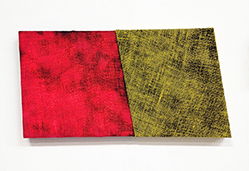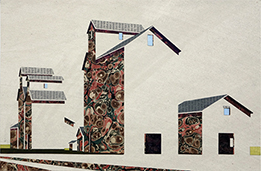 |
Focus features two in-depth reviews each month of fine art, architecture and design exhibitions and events at art museums, galleries and alternative spaces around Japan. The contributors are non-Japanese art critics living in Japan. |
|
|
 |
 |
 |
Koki Arts: A New and Different Gallery
Lucy Birmingham |
 |
Koki Ishibashi in his gallery Koki Arts, with an exhibition of paintings by Ryoichi Nakamura. Photograph by Lucy Birmingham |
|
Yoshishige Furukawa, Blue-1 (1997), oil on canvas, 34.5 x 34.3 cm |
Life as the child of a prominent artist is known to be challenging, but also rewarding for the many contacts and ingenuity it brings. The children of Pablo Picasso and Françoise Gilot -- son Claude and daughter Paloma -- are a familiar example. Both managed to skillfully navigate the fame and found success through their own creative ventures. Claude also started Picasso Administration to oversee the use and marketing of his father's works and name.
So it is intriguing to meet Koki Ishibashi, the son of two well-known Japanese artists: painter Yoshishige Furukawa (1921-2008) and sculptor Akiko Mashima (b. 1952). At 33, he is successfully pursuing a career in the arts as owner of Koki Arts in Tokyo. Opened in 2012 in the city's Bakurocho "mini-Soho" art district, the gallery shows a compelling mix of American and Japanese artists, from emerging to well-established.
Ishibashi's American contacts have been garnered since childhood, which he spent growing up in New York City's art world. He lived with his parents in the famed Westbeth artists' housing complex in the West Village. "I've been really lucky to be able to meet so many great artists," he says. His legendary neighbors included jazz musicians Gil Evans and John Scofield; choreographer Merce Cunningham had his dance studio on the top floor.
"The neighborhood, though, is next to the meat packing district, which was very dangerous when I was growing up," says Ishibashi. "But I remember seeing a lot of street art, which was great. Now that the neighborhood has been cleaned up it seems more like a tourist town."
When Ishibashi was born his father was 59. "But he was very energetic and looked young," he says. "He didn't look like he could be my grandfather. He'd be 93 if he were alive today." An established artist in Japan, Furukawa moved to New York City in 1963 to participate in the World Art Conference. His first trip back to Japan was in 1976 for an exhibition of his work in Tokyo. "My dad met my mother in 1976 at the time of his show. She was in her twenties and just out of art school, teaching art. She moved to New York to be with him."
 |
|
 |
|
|
|
Akiko Mashima, Existence 14-03 (2014), wood, paint, gloss, 291 x 291 cm |
|
Hisao Hanafusa, Uchuiden Kioku IX (2003), aluminum paint on canvas, 36 x 48 inches |
When Ishibashi was young he wanted to be a painter like his father, but his parents discouraged him. "It's not an easy life," he explains. As a teenager he was drawn to art history and felt the urge to study Japanese art. His first time to see ukiyo-e prints was at the Brooklyn Museum when he was 18. "I was mesmerized," he says. "They were so beautiful."
At Keio University in Tokyo he got his master's degree in art history with a focus on Hiroshige and Hokusai, and hoped to work as a curator in a Japanese museum. In the U.S. it would be a logical career step. But he quickly learned it was nearly impossible. "Museums in Japan rarely hire curators," he explains. "I couldn't wait for an opening."
The 2008 "Lehman Shock" hit the art market hard. Ishibashi lost his job at a company selling ukiyo-e prints. Ultimately, with confidence in his U.S. art contacts and guidance from his mother, he ventured into the risky business of art gallerist. "It was a big challenge. I didn't know many people in Japan's art world, and I didn't have any clients," he admits. "People would ask me what gallery I had worked at before."
Granted, his parents' contacts and their celebrated artworks have helped pave the way. One of Ishibashi's first exhibitions in 2012 was of his mother's black-and-white drawings -- a fresh, two-dimensional interpretation of her work as a three-dimensional sculptor of wood.
 |
|
 |
|
|
|
Natsuki Takayama, Untitled (2014), acrylic and oil on canvas, 72.7 x 72.7 cm |
|
Tatiana Berg, Karaoke Tent (2014), acrylic on canvas, wood, casters, 19.5 x 8 x 8 inches |
Her show was timed to promote the book Futari no New York (New York for Two) published that year. The volume features the complementary work of Mashima and Furukawa, who is known for his abstract paintings and lithographs with varied, bold shapes. His unusual technique using graphite sticks and rubber won him wide attention, and a following among young Japanese artists.
Ishibashi is now showing his father's work until March 28 in an exhibition titled Paintings from the 1990s. It is Furukawa's second posthumous show at Koki Arts, and appears in tandem with his retrospective at the Fukuoka Prefectural Museum of Art until March 15. "My father was born in Fukuoka but lived and worked in New York City for 40 years," Ishibashi explains.
Intriguingly, Furukawa and Japanese artists like him who worked in the U.S. after World War II could attract a new wave of interest from collectors, whose favoring of little-known artists from the postwar Japanese Gutai and Mono-ha art movements appears to have peaked.
Also on the roster at Koki Arts is Hisao Hanafusa, who could be counted as part of this group. Like Furukawa, he settled in New York City in the 1960s and created minimalist multimedia works. Later, he became a traditional Japanese furniture maker of some repute. His high-end store Miya Shoji offers fine, one-of-a kind wood furniture.
Ishibashi also shows young and talented Japanese artists such as award-winning painter Natsuki Takayama. Her depictions of animal and human figures are created with drops of acrylic paint on canvas.
 |
|
 |
|
|
|
Evan Nesbit, Variable Dimensions 2 (2014), acrylic and burlap, 40 x 76 cm |
|
William Steiger, Wheat Pool (Goldsmith) (2013), collage of vintage paper and gouache, 10 x 13 inches
All images are courtesy of Koki Arts. |
Veteran painter William Steiger is among the American artists Koki Arts represents in Japan. Steiger showed at the same gallery as Ishibashi's father in New York. "I first met him when I was eight years old. He was probably 28 at the time," Ishibashi says. Steiger's show at Koki Arts in 2013 was his first in Japan.
Last year Koki Arts showed American painter Evan Nesbit, who has since "attracted a huge amount of attention worldwide with his technique of paint pushed through the back of burlap," says Ishibashi.
Nesbit introduced Ishibashi to emerging American painter Tatiana Berg. He was able to see her Columbia University MFA thesis show last year, and will be showing her at Koki Arts from April 3 through May 9 this year.
Like most gallerists struggling in Tokyo's sluggish art market, Ishibashi is courting foreign collectors by participating in art fairs abroad. Many Tokyo-based galleries have opened satellite galleries in Singapore or Hong Kong, where the economy is strong and the art market is vibrant. "I don't feel, though, that I'm competing with other contemporary art galleries in Tokyo," says Ishibashi. "I'm doing something different by showing emerging American artists." And indeed this difference, while challenging, is rewarding for the resourcefulness and attention it brings.
|
|
|
 |
Yoshishige Furukawa: Paintings from the 1990s |
 |
Koki Arts |
 |
20 February - 28 March 2015 |
|
|
 |
 |
Lucy Birmingham
Lucy Birmingham is a long-time, Tokyo-based journalist, scriptwriter, author, and former photojournalist. She currently serves as president of the Foreign Correspondents' Club of Japan. She writes regularly for TIME magazine and her articles have appeared in many publications, including the Wall Street Journal, Newsweek, Bloomberg News, and Architectural Digest. As an arts and culture writer her articles have appeared in publications including Artinfo.com, Artforum.com, and ARTnews. She is also a scriptwriter and narrator for NHK (Japan's public broadcaster) and has published several books including Strong in the Rain: Surviving Japan's Earthquake, Tsunami, and Fukushima Nuclear Disaster.
lucybirmingham.com |
|
 |
|